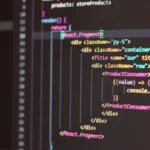Learn how to make a fast, SEO-friendly, and visually appealing blog using Next.js, a popular React framework. This step-by-step guide covers everything from setting up the project to deploying the final product. Get started on your Next.js blog today!
Next.js is a popular framework for creating web applications with React. It focuses on performance and SEO, providing native support for both static and dynamic pages. In this article, we’ll see how we can make a blog using Next.js.
Step 1: Set up a new Next.js project
You can use the command npx create-next-app to create a new Next.js project. This will install all necessary dependencies and set up the project structure for you.
Step 2: Define pages
In Next.js, each page is a React component. You can define pages in the pages directory. For example, you could create a file called index.js that serves as the home page for your blog, and a file called posts.js for your blog posts.
Step 3: Fetch data for pages
Next.js provides a convenient way to fetch data for pages using the getStaticProps and getServerSideProps methods. You can use these methods to fetch data from an API or a database and pass it to your pages as props.
Step 4: Style pages
Next.js provides built-in support for CSS-in-JS libraries like Styled Components. You can use these libraries to style your pages and components.
Step 5: Deploy your app
Next.js provides easy deployment options, including hosting on Vercel, which is a popular choice for Next.js projects. You can also deploy your app to other cloud hosting providers like AWS, Google Cloud, or Heroku.
These should give you a basic idea of how to make a blog using Next.js. You can also refer to the official Next.js documentation for more information and best practices.
In conclusion, Next.js is a powerful and flexible framework for creating web applications with React. By using these steps, you can quickly make a blog with Next.js that is fast, SEO-friendly, and visually appealing.
Here is a step-by-step code guide to create a basic blog with Next.js:
Step 1: Set up a new Next.js project
npx create-next-app my-blog
cd my-blog
npm run dev
Step 2: Define pages
Create a file called index.js in the pages directory and add the following code:
import React from 'react';
const Home = () => {
return (
<div>
<h1>Welcome to my blog</h1>
<p>This is the home page of my blog.</p>
</div>
);
};
export default Home;
Create another file called posts.js in the pages directory and add the following code:
import React from 'react';
const Posts = () => {
return (
<div>
<h1>Posts</h1>
<p>This is the page where all my blog posts will be displayed.</p>
</div>
);
};
export default Posts;
Step 3: Fetch data for pages
Create a file called data.js in the root directory and add the following code:
export const posts = [
{
id: 1,
title: 'First post',
content: 'This is the content of my first post.'
},
{
id: 2,
title: 'Second post',
content: 'This is the content of my second post.'
}
];
In the posts.js file, import the data and add the following code:
import React from 'react';
import { posts } from '../data';
const Posts = () => {
return (
<div>
<h1>Posts</h1>
{posts.map(post => (
<div key={post.id}>
<h2>{post.title}</h2>
<p>{post.content}</p>
</div>
))}
</div>
);
};
export default Posts;
Step 4: Style pages
Add the following code in the pages/_app.js file to include styling for the entire app:
import React from 'react';
import './app.css';
const MyApp = ({ Component, pageProps }) => {
return <Component {...pageProps} />;
};
export default MyApp;
Create a file called app.css in the pages directory and add the following styles:
body {
font-family: sans-serif;
margin: 0;
padding: 0;
}
h1, h2 {
text-align: center;
margin: 20px 0;
}
p {
margin: 20px;
text-align: justify;
}
Step 5: Deploy your app
To deploy your app, you can use Vercel, a popular platform for hosting Next.js applications. To get started, sign up for an account and follow
To deploy your Next.js blog on Vercel, you need to sign up for a Vercel account and then follow these steps:
- Connect your Github or GitLab repository where you have your Next.js blog code.
- Choose the repository that contains your Next.js blog code.
- In the “Settings” section, configure the build settings to match your project requirements. For a Next.js project, you can leave the default values.
- In the “Deployment” section, choose a custom domain name or a Vercel subdomain.
- Finally, click the “Deploy” button to start the deployment process.
- Your Next.js blog should now be deployed and accessible through the URL you have selected.
Note: Vercel offers a seamless deployment process and integrates well with Next.js. Other platforms, such as Heroku or AWS, can also be used to deploy your Next.js blog. The deployment process may differ, so you’ll need to follow their specific documentation.











